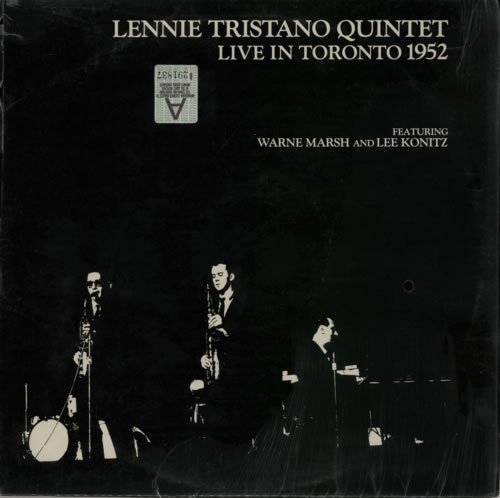Lennie Tristano Vinyl Records Lps For Sale
Check out these new and used Lennie Tristano vinyl records LPs for sale. We recommend starting your Lenny Tristano vinyl collection with the essential albums The New Tristano, Memorial Concert and Live In Toronto. Our inventory is always changing, so check back often, or browse our list of vinyl records for sale from jazz musicians.

Lennie Tristano: The Quiet Revolutionary of Modern Jazz
Lennie Tristano was a pianist, composer, and educator whose influence on jazz is both profound and often underappreciated. A visionary thinker and deeply original artist, Tristano stood apart from the jazz mainstream. He wasn’t interested in trends or popularity; he was devoted to innovation, discipline, and pushing the boundaries of improvisation. His legacy lives on not only in his groundbreaking recordings but also through the generations of musicians he mentored and inspired.
Born in Chicago in 1919 and blind from the age of 10, Tristano began studying music early in life. He was classically trained and developed a deep understanding of harmony, counterpoint, and rhythm. By the time he reached New York in the mid-1940s, he had a musical vocabulary that stood apart from most of his contemporaries. He wasn’t content to imitate—he was already developing a new language within jazz.
Tristano is most closely associated with the cool jazz movement, though that label doesn’t fully capture the scope of his work. He fused bebop complexity with classical structure and a cool, cerebral approach to improvisation. While bebop players like Charlie Parker and Dizzy Gillespie emphasized fiery speed and blues-based phrasing, Tristano pursued a more linear, contrapuntal style, often using intricate melodic lines and subtle harmonic shifts.
One of Tristano’s early innovations was in group improvisation. In recordings from the late 1940s, such as “Intuition” and “Digression,” he and his bandmates—including saxophonists Lee Konitz and Warne Marsh—created collective improvisations without predetermined chord progressions or forms. These recordings are considered among the first examples of free jazz, predating the more radical experiments of the 1960s by over a decade.
His 1956 self-titled album Lennie Tristano is a landmark in jazz history. The record included studio tracks that were meticulously constructed, edited, and in some cases overdubbed—an unusual and controversial approach at the time. On pieces like “Line Up” and “Turkish Mambo,” Tristano manipulated tape speed and layered rhythms in ways that foreshadowed techniques later used in electronic music and studio-based jazz fusion. The album remains one of the earliest examples of jazz embracing the recording studio as an instrument in itself.
Another key album in his discography is The New Tristano (1962), a solo piano project that showcases his deep rhythmic independence and harmonic inventiveness. The album is filled with complex counterpoint and unorthodox phrasing, with both hands functioning almost like separate instruments. Tracks like “C Minor Complex” and “G Minor Theme” reveal his mathematical mind and deep emotional control, creating music that feels spontaneous yet carefully structured.
Despite his limited commercial success and minimal public performances, Tristano built a devoted circle of students who absorbed his rigorous approach to music. Among them were alto saxophonist Lee Konitz and tenor saxophonist Warne Marsh, both of whom became important figures in cool jazz and continued Tristano’s legacy of linear improvisation. His teachings emphasized ear training, melodic fluency, and understanding the architecture of music rather than relying on rote patterns or clichés.
LENNY TRISTANO +ARNOLD ROSS =[EX JAZZ LP]=HOLIDAY IN PIANO =10" VINYL LP
 | $60.77 Buy It on eBay for only: $60.77 Buy It Now on eBay |
LENNIE TRISTANO NEW YORK IMPROVISATIONS (NM) PROMO 60264-1 LP VINYL RECORD
 | $19.99 Buy It on eBay for only: $19.99 Buy It Now on eBay |
Lennie Tristano - Self Titled Atlantic 1224 Mono w/ Lee Konitz VPI Cleaned
 | $17.06 Buy It on eBay for only: $17.06 Buy It Now on eBay |
Lennie Tristano ex original mono LP The New
 | $19.99 Buy It on eBay for only: $19.99 Buy It Now on eBay |
Lennie Tristano The New Tristano 1962 Vinyl Atlantic Records 1st Press Mono 1357
 | $69.99 Buy It on eBay for only: $69.99 Buy It Now on eBay |
SEALED! Org. US MONO Pressing LENNIE TRISTANO JAZZ RECORD SERIES LP RECORD 1224
 | $200.00 Buy It on eBay for only: $200.00 Buy It Now on eBay |
LENNIE TRISTANO QUARTET Self Titled 2LP '81 ATLANTIC Jazz SHRINK NM/NM
 | $10.98 Buy It on eBay for only: $10.98 Buy It Now on eBay |
Lennie Tristano Atlantic 1224 Mono 1956 Art Taylor Lee Konitz Peter Ind Vinyl LP
 | $20.69 Buy It on eBay for only: $20.69 Buy It Now on eBay |
Lee Konitz/Lennie Tristano S/T 1954 Vinyl Prestige Records 1st Press 10"
 | $69.99 Buy It on eBay for only: $69.99 Buy It Now on eBay |
HEAR - Rare Jazz 78 - The Lennie Tristano Sextette - Wow - Capitol # 57-60003
 | $19.99 Buy It on eBay for only: $19.99 Buy It Now on eBay |
Tristano’s influence can also be heard in the work of later innovators like Anthony Braxton, Carla Bley, and even modern pianists such as Brad Mehldau. His belief in artistic independence and personal expression laid the groundwork for the free jazz and avant-garde movements of the 1960s and beyond. He was also a precursor to many DIY musicians—recording and distributing music from his home studio, operating outside the traditional music industry.
Though often described as cold or overly intellectual by critics in his day, Tristano’s music contains a unique emotional intensity. It’s not emotional in the traditional blues-drenched sense, but rather in its clarity, structure, and commitment to truth. There’s an honesty in his playing that resists commercial polish. Every note is deliberate, every phrase considered, yet the result never feels stiff. In fact, the freedom within his form is what makes his music so enduring.
Lennie Tristano died in 1978, but his ideas live on. His recordings, though not extensive, are still studied by serious jazz musicians. More importantly, his approach to improvisation—as a disciplined, personal, and exploratory art form—continues to inspire those who want to move beyond imitation into innovation.
In a jazz world often driven by style and persona, Tristano was a quiet revolutionary. He didn’t chase fame. He didn’t bend to trends. Instead, he built a world of sound that was entirely his own. For those who enter that world, the rewards are rich—subtle, intricate, and deeply human. Lennie Tristano wasn’t just a great pianist—he was a master thinker in music, and his voice still echoes in the search for freedom and form in jazz today.





![GNX[LP] #1](https://m.media-amazon.com/images/I/51EXnBFIdPL._SL100_.jpg)

![Back to Black [Vinyl] #1](https://m.media-amazon.com/images/I/61Db7-hQGKL._SL100_.jpg)


![Gold - Greatest Hits[2 LP] #1](https://m.media-amazon.com/images/I/51mGW9UohWL._SL100_.jpg)
![Gold - Greatest Hits[2 LP] #2](https://m.media-amazon.com/images/I/410sx7AtHuL._SL100_.jpg)
![Gold - Greatest Hits[2 LP] #3](https://m.media-amazon.com/images/I/41PywevsgbL._SL100_.jpg)





![[Exquisite Appearance] Built from wood and metal materials with a unique sense of layering; The streamlined corner design is truly atmospheric and stylish(Note: long hold the start button to turn the power on, and press again to start) [All in 1] Thi...](https://m.media-amazon.com/images/I/41vovGjFkeL._SL160_.jpg)






































